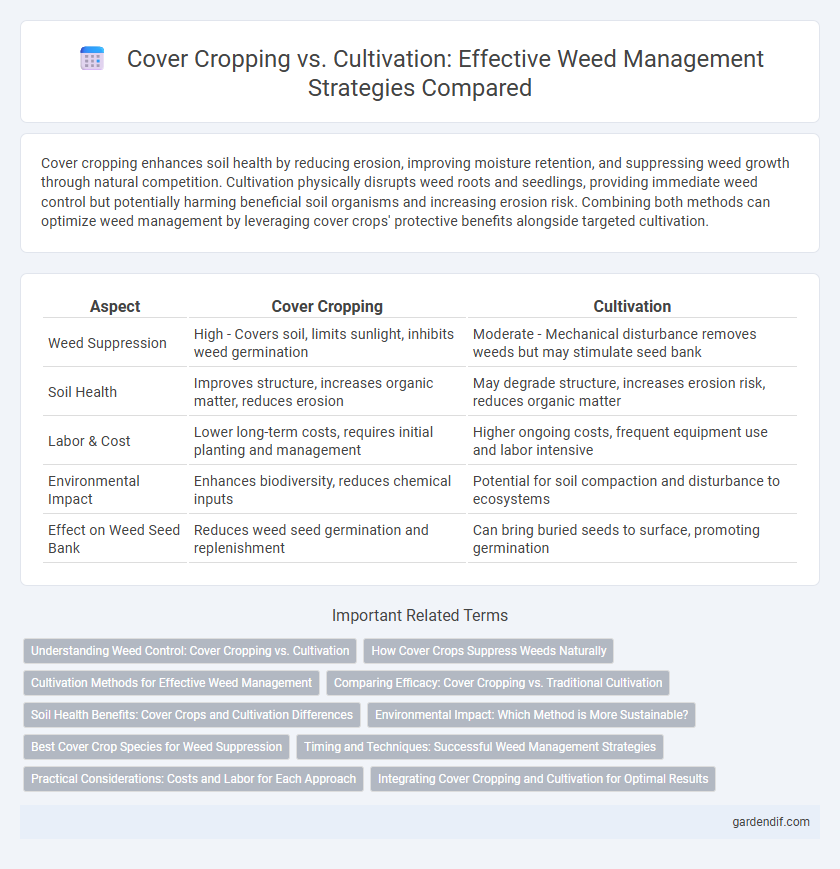
Cover cropping vs cultivation Illustration
Cover cropping enhances soil health by reducing erosion, improving moisture retention, and suppressing weed growth through natural competition. Cultivation physically disrupts weed roots and seedlings, providing immediate weed control but potentially harming beneficial soil organisms and increasing erosion risk. Combining both methods can optimize weed management by leveraging cover crops' protective benefits alongside targeted cultivation.
Table of Comparison
| Aspect | Cover Cropping | Cultivation |
|---|---|---|
| Weed Suppression | High - Covers soil, limits sunlight, inhibits weed germination | Moderate - Mechanical disturbance removes weeds but may stimulate seed bank |
| Soil Health | Improves structure, increases organic matter, reduces erosion | May degrade structure, increases erosion risk, reduces organic matter |
| Labor & Cost | Lower long-term costs, requires initial planting and management | Higher ongoing costs, frequent equipment use and labor intensive |
| Environmental Impact | Enhances biodiversity, reduces chemical inputs | Potential for soil compaction and disturbance to ecosystems |
| Effect on Weed Seed Bank | Reduces weed seed germination and replenishment | Can bring buried seeds to surface, promoting germination |
Understanding Weed Control: Cover Cropping vs. Cultivation
Cover cropping enhances weed control by suppressing weed germination through dense plant biomass and allelopathic effects, reducing reliance on mechanical disturbance. Cultivation disrupts established weed plants but may inadvertently promote weed seed germination by exposing soil and breaking weed root systems. Integrating cover cropping with judicious cultivation optimizes weed management by combining soil health benefits with targeted weed suppression strategies.
How Cover Crops Suppress Weeds Naturally
Cover crops suppress weeds naturally by outcompeting them for sunlight, nutrients, and moisture, creating a dense canopy that limits weed seed germination and growth. Leguminous cover crops such as clover release nitrogen into the soil, promoting vigorous crop growth that further inhibits weed establishment. Organic matter from decomposing cover crops improves soil health, enhancing microbial activity that can break down weed seed banks over time.
Cultivation Methods for Effective Weed Management
Cultivation methods such as shallow tillage and mechanical hoeing disrupt weed seed germination and root establishment, providing physical weed control while minimizing soil disturbance. Utilizing precision cultivation techniques targets weed patches efficiently, reducing competition with crops and preserving soil health. Integrating cultivation timing with weed life cycles enhances management effectiveness, especially when synchronized with early weed emergence.
Comparing Efficacy: Cover Cropping vs. Traditional Cultivation
Cover cropping suppresses weed growth by creating a competitive environment through dense plant coverage, reducing soil disturbance and enhancing organic matter, which decreases weed seed germination. Traditional cultivation disrupts weed plants physically, providing quick control but often leads to soil erosion and encourages weed seed exposure for future growth. Studies indicate cover cropping offers more sustainable, long-term weed management by improving soil health and minimizing weed emergence compared to repeated mechanical cultivation.
Soil Health Benefits: Cover Crops and Cultivation Differences
Cover cropping improves soil health by enhancing organic matter, increasing microbial activity, and preventing erosion, which leads to better nutrient retention and improved soil structure. Cultivation disrupts soil aggregates, reduces microbial diversity, and accelerates organic matter decomposition, often causing soil compaction and increased erosion risk. The long-term benefits of cover cropping surpass cultivation by maintaining soil fertility and promoting sustainable weed suppression through improved soil ecosystems.
Environmental Impact: Which Method is More Sustainable?
Cover cropping enhances soil health by increasing organic matter, reducing erosion, and promoting biodiversity, making it a sustainable alternative to traditional weed cultivation. Cultivation often disrupts soil structure, increases carbon emissions, and can lead to nutrient loss, negatively impacting long-term soil fertility. Sustainable weed management favors cover crops for their ability to suppress weeds naturally while supporting ecosystem services and reducing the need for chemical inputs.
Best Cover Crop Species for Weed Suppression
Cover crops like cereal rye, hairy vetch, and crimson clover are highly effective for weed suppression due to their rapid growth and dense canopy formation, which outcompetes weeds for light and nutrients. Species such as buckwheat and forage radish also contribute to weed control by creating allelopathic effects that inhibit weed seed germination. Selecting the best cover crop depends on soil type, climate, and crop rotation, with cereal rye often preferred for its robust residue and prolonged suppression benefits.
Timing and Techniques: Successful Weed Management Strategies
Cover cropping leverages timely planting of specific plant species to suppress weed emergence by shading and outcompeting weeds during vulnerable growth phases. Cultivation requires precise mechanical disruption of soil between crop rows at early weed growth stages to physically remove weeds without harming the crop. Integrating cover cropping before cultivation maximizes weed control by reducing weed seed banks and improving soil health, ensuring more sustainable and effective management.
Practical Considerations: Costs and Labor for Each Approach
Cover cropping reduces weed pressure by suppressing growth through dense plant mats, requiring upfront seed costs and moderate labor for planting and termination. Cultivation demands ongoing labor-intensive mechanical or manual weed control but typically involves lower initial expenses compared to cover crop seed and establishment. Evaluating these approaches depends on balancing long-term soil health benefits from cover crops against immediate labor availability and budget constraints for cultivation practices.
Integrating Cover Cropping and Cultivation for Optimal Results
Integrating cover cropping and cultivation enhances weed management by combining the soil-protective benefits of cover crops with targeted mechanical weed control. Cover crops suppress weed growth through shading and allelopathy, while cultivation disrupts weed seedlings and reduces seed banks. Employing both practices in rotation maximizes weed suppression, improves soil health, and promotes sustainable crop production.
Cover cropping vs cultivation Infographic

 gardendif.com
gardendif.com